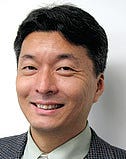Free of Lead and Full of Promise
May 1, 2009
R&D DIGEST
|
Takeuchi says that his research team has discovered a lead-free material that can be used to make ultrasound equipment. |
In search of novel materials, a research team has made a discovery that could appeal to medical device makers: bismuth samarium ferrite (BSFO). According to Ichiro Takeuchi, associate professor of materials science and engineering at the University of Maryland's A. James Clark School of Engineering, BSFO is a lead-free material with piezoelectric properties.
Currently, many transducers, actuators, and sensors are made from lead zirconate titanate (PZT). Although PZT's properties are ideal for electronic devices, the toxicity of lead is something OEMs should avoid—especially as regulations such as RoHS continue to restrict the amount of lead allowed in products.
The researchers found BSFO by using the “thin-film combinatorial approach,” Takeuchi says. Also known as “combi,” this screening process enables a large number of different samples to be synthesized and measured simultaneously. The method helped the researchers shave years off of their project, Takeuchi estimates. The University of Maryland's Keck Laboratory for Combinatorial Nanosynthesis and Multiscale Characterization is one of the few laboratories in the world with the capability to perform combi.
For Takeuchi's project, a precisely controlled laser blasted away molecular-sized pieces of bismuth ferrite and samarium ferrite. Those pieces were then deposited in thin films on a chip. Each film contained a varying proportion of the original ingredients. Multiple layers of the film combine to create continuously varying formulas. A collection of these samples housed on a chip is known as a combinatorial library.
|
Shown here is an example of a combinatorial chip, part of a magnetic smart materials library. The pink areas hold no magnetic properties. |
Takeuchi says that his research team was building such libraries to find “novel function materials.” When looking at their sample of new materials, they found that piezoelectric properties always occurred in instances in which the atomic-scale structures were on the verge of changing from one crystal structure to another. They looked at several hundred materials before settling on BSFO.
“It is simultaneously ferroelectric and magnetic,” Takeuchi says. In addition to its piezoelectric properties, BSFO can operate at higher temperatures than other proposed lead-free alternatives, and it is also easier to create.
Medical manufacturers can use BSFO for any product that requires both mechanical sensing and actuation. For example, “ultrasound imaging equipment can use this new piezoelectricity to generate the ultrasound signal,” Takeuchi says.
The University of Maryland researchers are currently performing bulk scale-up studies of BSFO and trying to attract industry interest. They have filed a provisional patent for the material.
Takeuchi's collaborators include Clark School of Engineering alumni Shigehiro Fujino and Sung-Hwan Lim; former postdoctoral fellow Makoto Murakami; Clark School materials science and engineering faculty members Manfred Wutting and Lourdes Salamanca-Riba; and University of New South Wales (Australia) faculty Varantharajan Anbusathaiah and Valanoor Nagarajan.
The project is funded by the Keck Foundation, the National Science Foundation's Materials Research Science and Engineering Center, and the Army Research Office. The discovery of BSFO was recently profiled in a 2008 issue of Applied Physics Letters.
Copyright ©2009 Medical Device & Diagnostic Industry
About the Author(s)
You May Also Like



.png?width=300&auto=webp&quality=80&disable=upscale)
